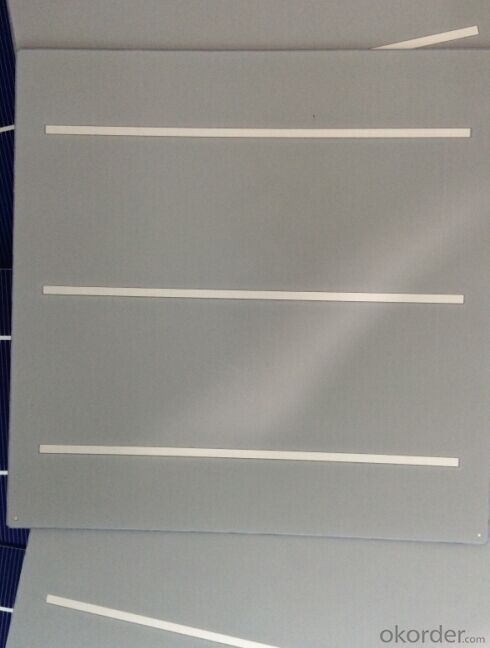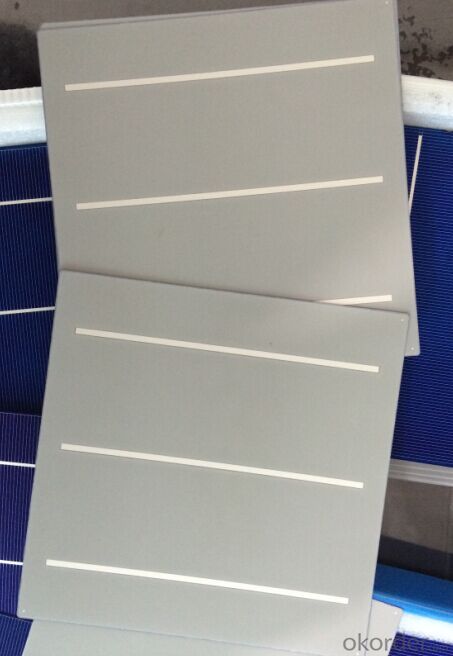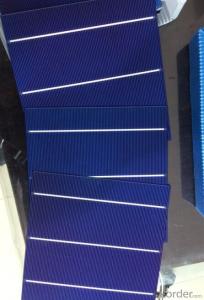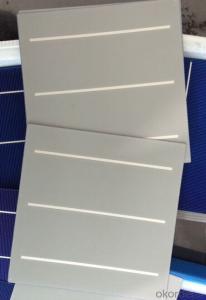Poly Solar Cells Lower than 4Watt Eff Better Price
- Loading Port:
- Shanghai
- Payment Terms:
- TT or LC
- Min Order Qty:
- 30000 pc
- Supply Capability:
- 1000000 pc/month
OKorder Service Pledge
OKorder Financial Service
You Might Also Like
Electrical Characteristic
Efficiency (%) | Pmpp (W) | Umpp (V) | Impp (A) | Uoc (V) | Isc (A) | FF (%) |
17.25 | 4.197 | 0.524 | 7.992 | 0.62 | 8.458 | 80.03% |
17 | 4.137 | 0.524 | 7.876 | 0.619 | 8.353 | 80.01% |
16.75 | 4.076 | 0.522 | 7.81 | 0.617 | 8.286 | 79.73% |
16.5 | 4.015 | 0.518 | 7.746 | 0.613 | 8.215 | 79.73 |
16.25 | 3.955 | 0.515 | 7.683 | 0.61 | 8.144 | 79.61% |
16 | 3.894 | 0.512 | 7.613 | 0.608 | 8.075 | 79.31% |
15.75 | 3.833 | 0.51 | 7.534 | 0.605 | 8.058 | 78.62% |
15.5 | 3.772 | 0.508 | 7.453 | 0.604 | 8.02 | 77.87% |
15.25 | 3.771 | 0.505 | 7.35 | 0.604 | 9.997 | 76.83% |
15 | 3.65 | 0.503 | 7.271 | 0.604 | 7.989 | 75.64% |
14.5 | 3.529 | 0.499 | 7.067 | 0.604 | 7.988 | 73.14% |
14 | 3.407 | 0.499 | 6.833 | 0.604 | 7.833 | 72.01% |
Advantage Of Poly Solar Cell 156mm
1: High quality cell, Level A cell (14%—17.5%)
2.Dimensione:156*156mm Diagonal:200mm
3: Qualified certification: TUV,CE certification.
4: Warranty: five years for whole unit
Usage/Application Of Poly Solar Cell 156mm
Packaging & Delivery Of Poly Solar Cell 156mm | |
Packaging Detai | Packaging Detail:Export Carton and Pallet or under customer request. |
Delivery Detail:10-20days | |


Solar cells are typically named after the semiconducting material they are made of. These materials must have certain characteristics in order to absorb sunlight. Some cells are designed to handle sunlight that reaches the Earth's surface, while others are optimized for use in space. Solar cells can be made of only one single layer of light-absorbing material (single-junction) or use multiple physical configurations (multi-junctions) to take advantage of various absorption and charge separation mechanisms.
- Q:How are solar cells manufactured?
- Solar cells are manufactured through a multi-step process that involves the production of silicon wafers, the creation of a p-n junction, the addition of anti-reflective coatings, and the assembly of electrical contacts.
- Q:What is the difference between solar cells and solar panels?
- Solar cells and solar panels are often used interchangeably, but there is a slight difference between the two. Solar cells, also known as photovoltaic cells, are the individual units that convert sunlight into electricity through the photovoltaic effect. On the other hand, solar panels are made up of multiple solar cells interconnected to form a larger module, which is capable of generating a higher amount of electricity. In simple terms, solar cells are the building blocks, whereas solar panels are the final product that harnesses solar energy for power generation.
- Q:Can solar cells be used in satellites?
- Yes, solar cells can be used in satellites. They are commonly used to convert sunlight into electricity, providing a reliable and renewable source of power for satellite operations.
- Q:How do solar cells handle electrical noise or interference?
- Solar cells do not handle electrical noise or interference. They convert sunlight directly into electricity and are not designed to address or mitigate electrical noise or interference.
- Q:Can solar cells be used to power satellites?
- Yes, solar cells can be used to power satellites. In fact, they are the primary source of power for most satellites in space. Solar cells convert sunlight into electricity, which is then used to power the various systems and instruments on board the satellite.
- Q:What is the impact of pollution or smog on solar cell performance?
- The impact of pollution or smog on solar cell performance is significant. Pollutants in the air, such as particulate matter and chemicals, can accumulate on the surface of solar panels, reducing their efficiency by blocking or scattering sunlight. This leads to a decrease in the amount of electricity generated by the solar cells. Smog, which is a combination of smoke and fog, can further exacerbate the problem by reducing the amount of sunlight reaching the solar panels. Overall, pollution and smog can significantly hamper the performance of solar cells, resulting in lower energy production.
- Q:What is the lifespan of solar cells?
- The lifespan of solar cells can vary, but on average, they are designed to last for 25 to 30 years.
- Q:What is the role of charge controllers in solar cell systems?
- The role of charge controllers in solar cell systems is to regulate the flow of electrical current between the solar panels and the batteries. They prevent overcharging of the batteries by monitoring the voltage and current levels, ensuring efficient charging and maximizing the lifespan of the batteries. Additionally, charge controllers protect the batteries from being drained excessively by disconnecting the load when the battery voltage drops to a certain level. Overall, charge controllers are crucial in maintaining the integrity and performance of solar cell systems.
- Q:How are solar cells used in calculators?
- Solar cells are used in calculators to convert sunlight into electrical energy, which powers the device and allows it to function without the need for batteries or external power sources.
- Q:How do solar cells perform in areas with extreme temperature fluctuations?
- Solar cells typically perform well in areas with extreme temperature fluctuations. However, excessive heat can slightly reduce their efficiency, while extreme cold can temporarily decrease their power output. Nonetheless, solar cells are designed to withstand a wide range of temperatures, and advancements in technology have improved their performance and durability in extreme weather conditions.
1. Manufacturer Overview |
|
|---|---|
| Location | |
| Year Established | |
| Annual Output Value | |
| Main Markets | |
| Company Certifications | |
2. Manufacturer Certificates |
|
|---|---|
| a) Certification Name | |
| Range | |
| Reference | |
| Validity Period | |
3. Manufacturer Capability |
|
|---|---|
| a)Trade Capacity | |
| Nearest Port | |
| Export Percentage | |
| No.of Employees in Trade Department | |
| Language Spoken: | |
| b)Factory Information | |
| Factory Size: | |
| No. of Production Lines | |
| Contract Manufacturing | |
| Product Price Range | |
Send your message to us
Poly Solar Cells Lower than 4Watt Eff Better Price
- Loading Port:
- Shanghai
- Payment Terms:
- TT or LC
- Min Order Qty:
- 30000 pc
- Supply Capability:
- 1000000 pc/month
OKorder Service Pledge
OKorder Financial Service
Similar products
New products
Hot products
Hot Searches
Related keywords



























